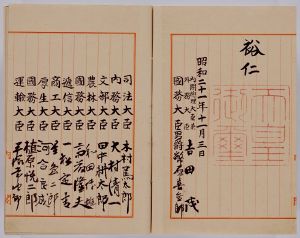Yoshida Shigeru
Shigeru Yoshida (吉田 茂 Yoshida Shigeru), September 22, 1878–October 20, 1967, was a Japanese diplomat and politician who served as Prime Minister of Japan from 1946 to 1947 and from 1948 to 1954. His policies, emphasizing Japan's economic recovery and a reliance on US military protection at the expense of independence in foreign affairs, became known as the "Yoshida Doctrine" and shaped Japanese foreign policy during the Cold War era and beyond.
Early life
Yoshida was born in Tokyo and educated at Tokyo Imperial University. He entered Japan's diplomatic corps in 1906 just after Japan's victory against Russia in the Russo-Japanese War. He was Japan's ambassador to Italy and the United Kingdom during the 1930s and finally retired from his last appointment as ambassador to London in 1938. Throughout the 1930's and before the war ended in the early 1940's Yoshida continued to participate in Japan's imperialist movement. After several months' imprisonment in 1945, he became one of Japan's key postwar leaders.
As Prime Minister
Yoshida became the 45th prime minister on May 22,1946. His pro-United States and pro-British ideals and his knowledge of Western societies, gained through education and political work abroad are what made him the perfect candidate in the eyes of the Post-WWII Allied Occupation. After being replaced with Tetsu Katayama on May 24, 1947, he returned to the post as the 48th prime minister on October 15, 1948.
Under Yoshida's rule, Japan began to rebuild its lost industrial infrastructure and placed a premium on unrestrained economic growth. Many of these concepts still impact Japan's political and economic policies, however since the 1970's environmental movement, the bursting of Japan's economic bubble, and the end of the Cold War, Japan has been struggling to redefine its national goals.
He was retained in three succeeding elections (49th: February 16, 1949; 50th: October 30,1952; and 51st: May 21, 1953), and was finally ousted on December 10,1954, when he was replaced by Ichirō Hatoyama. He retired from the Diet of Japan in 1955.
Yoshida's grandson, Taro Aso, is the current Foreign Minister.
| Preceded by: Mamoru Shigemitsu |
Minister for Foreign Affairs of Japan 1945–1947 |
Succeeded by: Hitoshi Ashida |
| Preceded by: Hitoshi Ashida |
Minister for Foreign Affairs of Japan 1948–1954 |
Succeeded by: Mamoru Shigemitsu |
Template:Japanese prime ministers
Template:Japan-bio-stub
de:Shigeru Yoshida fr:Shigeru Yoshida it:Shigeru Yoshida he:שיגרו יושידה nl:Yoshida Shigeru ja:吉田茂 pt:Shigeru Yoshida zh:吉田茂
Credits
New World Encyclopedia writers and editors rewrote and completed the Wikipedia article in accordance with New World Encyclopedia standards. This article abides by terms of the Creative Commons CC-by-sa 3.0 License (CC-by-sa), which may be used and disseminated with proper attribution. Credit is due under the terms of this license that can reference both the New World Encyclopedia contributors and the selfless volunteer contributors of the Wikimedia Foundation. To cite this article click here for a list of acceptable citing formats.The history of earlier contributions by wikipedians is accessible to researchers here:
The history of this article since it was imported to New World Encyclopedia:
Note: Some restrictions may apply to use of individual images which are separately licensed.
